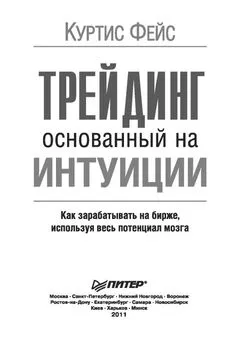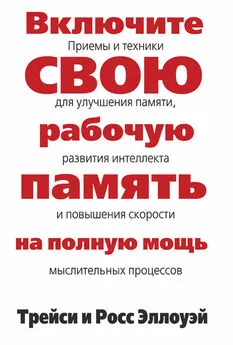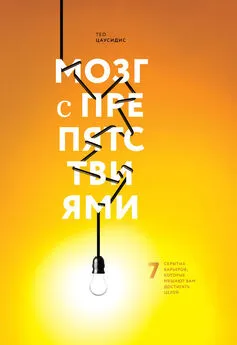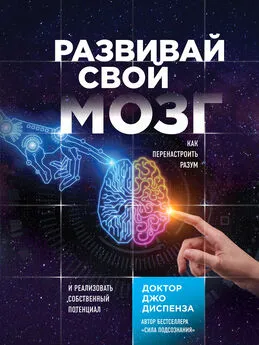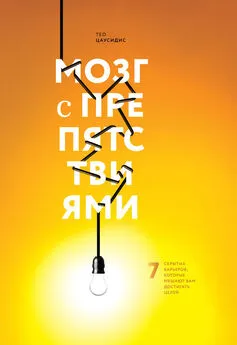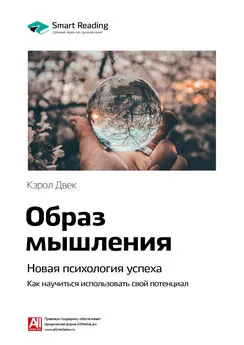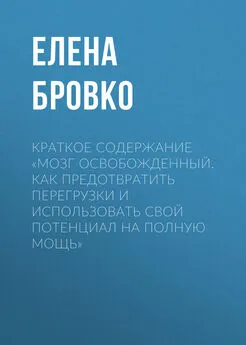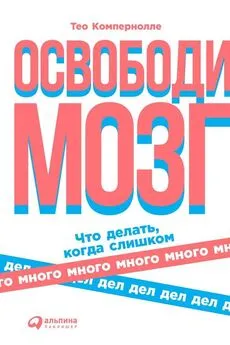Тео Компернолле - Мозг освобожденный. Как предотвратить перегрузки и использовать свой потенциал на полную мощь
- Название:Мозг освобожденный. Как предотвратить перегрузки и использовать свой потенциал на полную мощь
- Автор:
- Жанр:
- Издательство:Array Литагент «Альпина»
- Год:2015
- Город:Москва
- ISBN:978-5-9614-3976-1
- Рейтинг:
- Избранное:Добавить в избранное
-
Отзывы:
-
Ваша оценка:
Тео Компернолле - Мозг освобожденный. Как предотвратить перегрузки и использовать свой потенциал на полную мощь краткое содержание
Мозг освобожденный. Как предотвратить перегрузки и использовать свой потенциал на полную мощь - читать онлайн бесплатно полную версию (весь текст целиком)
Интервал:
Закладка:
Daily computer usage correlated with undergraduate students’ musculoskeletal symptoms. Che-hsu (Joe) Chang P.T., MS, Benjamin C. Amick III PhD, Cammie Chaumont Menendez MPH, MS, Jeffrey N. Katz MD, MS, Peter W. Johnson PhD, Michelle Robertson PhD, CPE, Jack Tigh Dennerlein PhD, American Journal of Industrial Medicine. Volume 50, Issue 6, June 2007, pp. 481–488.
243
A comparison of the influence of electronic books and paper books on reading comprehension, eye fatigue, and perception,Hanho Jeong, (2012) “Electronic Library, Vol. 30 Iss: 3, pp. 390–408.
Reading from an LCD monitor versus paper: Teenagers’ reading performance. Hak Joon Kim, Joan Kim. Computers in Human Behavior. Volume 28, Issue 5, Sept 2012, pp. 1816–1828.
http://consortiacademia.org/index.php/ijrset/article/view/170
Taking readingcomprehension exams on screen or on paper? A metacognitive analysis of learning texts under time pressure Rakefet Ackerman, Tirza Lauterman. Computers in Human Behavior. Volume 28, Issue 5, Sept 2012, pp. 1816–1828.
Usability evaluation of E-books. Yen-Yu Kanga, Mao-Jiun J. Wangb, Rungtai LincDisplays. Volume 30, Issue 2, April 2009, pp. 49–52. Comprehension and workload differences for VDT and paperbased reading. Daniel K. Mayes,Valerie K. Sims, Jefferson M. Koonce. International Journal of Industrial Ergonomics. Volume 28, Issue 6, Dec 2001, pp. 367–378.
244
Psychophysiological Patterns During Cell Phone Text Messaging: A Preliminary Study. I-Mei Lin, Erik Peper. Applied Psychophysiology and Biofeedback. March 2009, Volume 34, Issue 1, pp. 53–57.
Musculoskeletal symptoms among mobile hand-held device users and their relationship to device use: a preliminary study in a canadian university population. S. Berolo, R.P. Wells, B.C. Amick 3rd. Appl. Ergon., 42 (2) (2010), pp. 371–378.
Musculoskeletal symptoms among mobile hand-held device users and their relationship to device use: A preliminary study in a Canadian university population, Sophia Berolo, Richard P. Wells, Benjamin C. Amick III, Applied Ergonomics, Volume 42, Issue 2, January 2011, pp. 371–378.
Self-reported neck symptoms and use of personal computers, laptops and cell phones among Finns aged 18–65. Leena Korpinenab, Rauno Pääkkӧnenc Fabriziomaria Gobbad. Ergonomics. Volume 56, Issue 7, 2013, pp. 1134–1146.
245
Psychophysiological Patterns During Cell Phone Text Messaging: A Preliminary Study. I-Mei Lin, Erik Peper. Applied Psychophysiology and Biofeedback, March 2009, Volume 34, Issue 1, pp. 53–57.
Musculoskeletal symptoms among mobile hand-held device users and their relationship to device use: a preliminary study in a canadian university population. S. Berolo, R.P. Wells, B.C. Amick 3rd. Appl. Ergon., 42 (2) (2010), pp. 371–378.
Musculoskeletal symptoms among mobile hand-held device users and their relationship to device use: A preliminary study in a Canadian university population, Sophia Berolo, Richard P. Wells, Benjamin C. Amick III, Applied Ergonomics, Volume 42, Issue 2, January 2011, pp. 371–378.
Self-reported neck symptoms and use of personal computers, laptops and cell phones among Finns aged 18–65. Leena Korpinenab, Rauno Pääkkӧnenc Fabriziomaria Gobbad. Ergonomics. Volume 56, Issue 7, 2013, pp. 1134–1146.
246
http://www.forbes.com/sites/nextavenue/2013/06/07/how-textingcan-give-you-a-permanent-pain-in-theneck/
247
Cervicogenic headache: Clinical presentation, diagnostic criteria, and differential diagnosis. Fabio Antonaci MD, PhD, Torbjorn A. Fredriksen MD, PhD, Ottar Sjaastad MD, PhD. Current Pain and Headache Reports. 2001, Volume 5, Issue 4, pp. 387–392.
Cervicogenic headache: an assessment of the evidence on clinical diagnosis, invasive tests, and treatment, Nikolai Bogduk, Jayantilal Govind, The Lancet Neurology, Volume 8, Issue 10, October 2009, pp. 959–968.
Musculoskeletal physical outcome measures in individuals with tensiontype headache: A scoping review. Jacques Abboud, Andree-Anne Marchand, Karin Sorra, Martin Descarreaux. Cephalalgia, June 26, 2013.
Reinvestigation of the dysfunction in neck and shoulder girdle muscles as the reason of cervicogenic headache among office workers. Juliusz Huber, Przemysworkers. Juliusz Huber, Przemysław Lisiński, Agnieszka Polowczyk. Disability and Rehabilitation, May 2013, Vol. 35, No. 10, pp. 793–802.
Review Cervicogenic headache: an assessment of the evidence on clinical diagnosis, invasive tests, and treatment. Bogduk N, Govind J. Lancet Neurol, Oct 2009; 8(10); pp. 959–968.
Review Cervicogenic headache: anatomic basis and pathophysiologic mechanisms. Bogduk N. Curr Pain Headache Rep, Aug 2001; 5(4); pp. 382–386.
Review Cervicogenic headaches: a critical review. Haldeman S, Dagenais S. Spine J. 2001 Jan-Feb; 1(1); pp. 31–46.
248
Dry Eyes and Video Display Terminals. Kazuo Tsubota, M.D. Katsu Nakamori, Ph.D. N Engl J Med 1993; 328:584, 25 Feb 1993. http://www.nejm.org/doi/full/10.1056/NEJM199302253280817
Eye blink frequency during different computer tasks quantified by electrooculography. J. H. Skotte, J. K. Nojgaard, L. V. Jorgensen, K. B. Christensen, G. Sjøgaard. European Journal of Applied Physiology, Jan 2007, Volume 99, Issue 2, pp. 113–119.
Blink Rate, Incomplete Blinks and Computer Vision Syndrome. Portello, Joan K.; Rosenfield, Mark; Chu, Christina A. Optometry & Vision Science, May 2013, Volume 90, Issue 5, pp. 482–487.
249
I am very happy with my “Pluggable®”.
250
Posture, muscle activity and muscle fatigue in prolonged VDT work at different screen height settings. Jan Seghers, Arnaud Jochem & Arthur Spaepen. Ergonomics. Volume 46, Issue 7, 2000, pp. 714–730.
Development and evaluation of an office ergonomic risk checklist: ROSA– Rapid office strain assessment, Michael Sonne, Dino L. Villalta, David M. Andrews, Applied Ergonomics, Volume 43, Issue 1, Jan 2012, pp. 98–108.
Assessing Posture While Typing on Portable Computing Devices in Traditional Work Environments and at Home. Abigail J. Werth Kari Babski-Reeves, Ph.D., CPEProceedings of the Human Factors and Ergonomics Society Annual Meeting, Sept 2012, vol. 56, no. 1, pp. 1258–1262.
An ergonomics training program for student notebook computer users: Preliminary outcomes of a six-year cohort study. Karen Jacobs and others. Journal of Prevention, Assessment and Rehabilitation. Volume – Volume 44. Issue 2, pp. 221–230.
Wrist and shoulder posture and muscle activity during touch-screen tablet use: Effects of usage configuration, tablet type, and interacting hand. Justin G. Young, Matthieu B. Trudeau, Dan Odell, Kim Marinelli, Jack T. Dennerlein Journal of Prevention, Assessment and Rehabilitation (pre-press: http://iospress.metapress.com/content/w12751t54x304550/).
251
Osteoarthritis of the thumb carpometacarpal joint in women and occupational risk factors: a caseccupationalrpom L. Fontana, S. Neel, J.-M. Claise, S. Ughetto, P. Catilina. J. Hand Surg. Am., 32 (2007), pp. 459–465.
Texting tenosynovitis. E.F. Storr, F.O. De Vere Beavis, M.D. Stringer. N. Z. Med. J., 120 (1267) (2007), p. 2868.
“Texting” tendinits. R.J. Menz, Med. J. Aust., 182 (6) (2005), p. 308.
Excessive texting in pathophysiology of first carpometacarpal joint arthritis. Z. Ming, S. Pietikainen, O. Hanninen. Pathophysiology, 13 (4) (2006), pp. 269–270.
Musculoskeletal symptoms among mobile hand-held device users and their relationship to device use: A preliminary study in a Canadian university population, Sophia Berolo, Richard P. Wells, Benjamin C. Amick III, Applied Ergonomics, Volume 42, Issue 2, Jan 2011, pp. 371–378.
252
Accuracy and feasibility of using an electrogoniometer for measuring simple thumb movements. Per Jonsson, Peter W. Johnsonb & Mats Hagberga. Ergonomics. Volume 50, Issue 5, 2007, pp. 647–659.
253
Thumbs up and down. Erin Walkinshaw. Canadian Medical Association Journal, Aug 9 2011. vol. 183, no. 11 E711-E712. http://www.cmaj.ca/content/183/11/E711.short
Risk factors and clinical features of text message injuries. Deepak Sharan and Ajeesh PS.Tiasnimbas1Work 41 (2012), pp. 1145–1148. http://iospress.metapress.com/content/a465852l108263n9/fulltext.pdf
254
Live from Apple’s iPhone OS 4 event! Joshua Topolsky, 8 April 2010. http://www.engadget.com/2010/04/08/live-from-apples-iphone-os-4-event/
255
On Touch Screens, Rest Your Finger by Using a Stylus. David Pogue. The New York Times, Aug 1, 2012.
256
Sleep Loss and Fatigue in Residency Training. A Reappraisal. Sigrid Veasey. JAMA. 2002; 288(9); pp. 1116–1124.
Patterns of performance degradation and restoration during sleep restriction and subsequent recovery: a sleep doseresponse study. Gregory Belenky, et al. J. Sleep Res. (2003) 12, 1–12.
Too Little Sleep: The New Performance Killer. By Margaret Heffernan BNET, Feb 10, 2011.
Effect of Reducing Interns’ Weekly Work Hours on Sleep and Attentional Failures. Steven W. Lockley, et al. New England J. of Medecine, October 28, 2004.
Extended Work Shifts and the Risk of Motor Vehicle Crashes among Interns. Laura K. Barge et al. New England J. of Medecine, January 13, 2005.
Effects of Health Care Provider Work Hours and Sleep Deprivation on Safety and Performance. Lockley, Steven W. et al. Joint Commission Journal on Quality and Patient Safety, Volume 33, Supplement 1, November 2007, pp 7–18(12).
Transport and industrial safety, how are they affected by sleepiness and sleep restriction? Pierre Philip, Torbjorn Åkerstedt. Sleep Medicine Reviews. Volume 10, Issue 5, October 2006, pp. 347–356.
Suppression of sleepiness and melatonin by bright light exposure during breaks in night work. T. Akerstedt, G. Kecklund, S.E. Johansson. Shift work and mortality. A. Lowden, T. Åkerstedt, R. Wibomhronobiol Int, 21 (6) (2004), pp. 1055–1061.
Trends in the risk of accidents and injuries and their implications for models of fatigue and performance. S. Folkard, T. Åkerstedt. Aviat Space Environ Med, 75 (3) (2004), pp. A161–A167.
Sleep on the night shift: 24-hour EEG monitoring of spontaneous sleep/wake behavior. L. Torsvall, T. Åkerstedt, K. Gillander, A. Knutsson. Psychophysiology, 26 (3) (1989), pp. 352–358.
A prospective study of fatal occupational accidents – relationship to sleeping difficulties and occupational factors. T. Åkerstedt, P. Fredlund, M. Gillberg, B. Jansson. J Sleep Res, 11 (2002), pp. 69–71.
Mortality associated with sleep duration and insomnia. D.F. Kripke, L. Garfinkel, D.L. Wingard, M.R. Klauber, M.R. Marler. Arch Gen Psychiatr, 59 (2002), pp. 131–136.
The impact of sleep deprivation on decision making: A review. Harrison, Yvonne; Horne, James A. Journal of Experimental Psychology: Applied, Vol. 6(3), Sep 2000.
Junior doctors’ extended work hours and the effects on their performance: the Irish case. Fiona Flinn and Claire Armstrong. Int. J. Qual Health Care (2011) 23(2), pp. 210–217.
Sleeping brain, learning brain. The role of sleep for memory systems. Peigneux, Philippe et al. Neuroreport, 21 Dec 2001; Volume 12; Issue 18; pp. A111-A124.
Immune, inflammatory and cardiovascular consequences of sleep restriction and recovery. Brice Faraut, Karim Zouaoui Boudjeltia, Luc Vanhamme, Myriam Kerkhofs. Sleep Medicine Reviews. Volume 16, Issue 2, April 2012, pp. 137–149.
Читать дальшеИнтервал:
Закладка:

